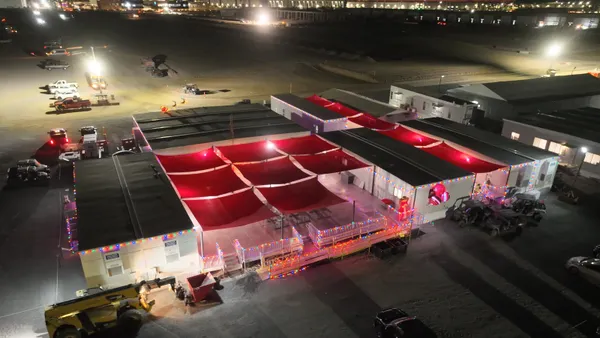Utilizing 3D printers to build structures like homes and bridges seemed far-fetched as recent as five years ago. But researchers and companies across the world are using the technology on a large scale and demonstrating the cost, efficiency and resiliency of the method.
Construction Dive rounded up three noteworthy developments that have been made in the 3D printing space just this month.
3D-printed concrete pedestrian bridge is world’s longest
Researchers at Tsinghua University’s School of Architecture recently opened the world’s longest 3D-printed concrete pedestrian bridge in Shanghai, China. The 26.3-meter single-arch structure is constructed from 44 hollow 3D-printed units, while the handrails, which enclose the 3.6-meter width, are built from 68 printed units.
A 1:4 scale model of the bridge, which was digitally designed with cost efficiency in mind, was heavily tested for strength and viability prior to printing. Two robotic arms were used to print the actual structure over the course of 450 hours, shaving an estimated 33% of time off the conventional bridge construction process by eliminating the need for reinforcing bars, among other elements.
The bridge also is embedded with sensors that provide real-time data on vibration and stresses in order to better inform the researchers on the practical performance of 3D-printed concrete structures.
Printed house and bridge factory debuts in Europe
Industrial mortar manufacturer Weber Beamix and civil engineering company BAM Infra recently opened a facility in Eindhoven, the Netherlands, that officials are calling Europe’s first 3D-printed concrete factory. The Eindhoven University of Technology, which produced the world’s first 3D-printed concrete bridge in 2017 and helped conceptualize a neighborhood of concrete-printed homes, is also involved in the project.
The facility will be used to develop concrete printed parts quickly and efficiently in an industrial environment, including components for the five residences that will compose the 3D-printed community. The collaborating companies hope to stimulate innovation that will reduce the amount of concrete that is needed for structures (due to its harmful CO2 emissions) as well as reduce errors in the 3D-printing process.
Home builder shares 3D-printing template
Sunconomy, a Texas-based tiny home builder, and residential developer Forge New recently teamed up to lease and license Sunconomy’s We Print Houses 3D-printing home technology to U.S. builders and contractors.
We Print Houses offers three adaptable plans that utilize self-binding geopolymer concrete, which Sunconomy says can withstand extreme weather events and reduce homeowners’ energy and maintenance costs. Sunconomy will offer exclusive regional licenses to the first 25 firms that qualify, and will equip them with the necessary robotic systems, mobile platform, in-person training and support. The homes can reportedly be printed and assembled in weeks, saving time and labor expenses.














